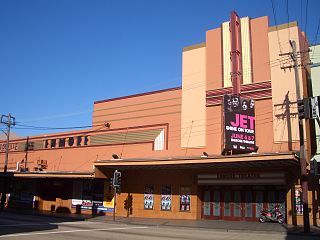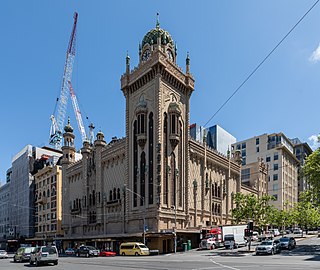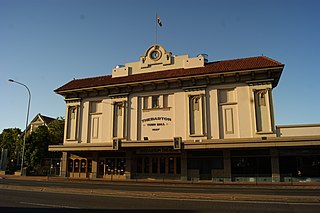
The Hoyts Group of companies in Australia and New Zealand includes Hoyts Cinemas and Val Morgan. Hoyts operates more than 450 cinema screens and 55,000 seats, making it Australia's second largest movie exhibitor after Event Hospitality & Entertainment. Val Morgan sells advertising on cinema screens and digital billboards.

The Metro Theatre is a music venue located on George Street, in the city centre of Sydney, Australia. The venue was redeveloped, from two former cinemas, by property developer Leon Fink.

The Enmore Theatre is a theatre and entertainment venue in Sydney, Australia. It was built in 1908. It is located at 118–132 Enmore Road in Newtown, in the inner west of Sydney's suburbs. It was first opened in 1912 as a photo-play theatre. It was run by a well-known theatre family at the time, the Szarka Brothers. Today's Enmore Theatre is the longest running live theatre in Sydney, hosting concerts, comedians, plays and all forms of performance. The theatre is considered a medium-sized venue that holds 1,700 people when fully seated and 2,500 when seats are removed, and all attendees are standing. It has hosted many international bands including a performance by Bob Dylan. The venue's art deco style is protected by its listing as a historic building within Sydney. The Enmore theatre has had many renovations and shifts of ownership. Today it is owned by Century and has hosted a range of arts from photographic, performing arts, music and motion picture. The theatre's listing in the Office of Environment and Heritage states that the building "illustrates the development of suburban theatres in the late 1930s and early 1940s and is of social significance for the local community.″ It is the only theatre in Sydney from the Art Deco movement in its original condition. From cinema use to concerts, today is used for various reasons.

The Capitol is an historic theatre on Swanston Street in the central business district (CBD) of Melbourne, Victoria, Australia. Opened in 1924 as part of the Capitol House building, the art deco theatre was designed by American husband and wife architects Walter Burley and Marion Mahony Griffin, and is the oldest of Melbourne's large picture palaces. It is famous for its extravagant decor and abstract motifs, including an intricate geometric ceiling containing thousands of coloured lamps, designed to evoke the walls of a crystalline cave.

The Forum Theatre is a historic theatre and former cinema now used as a live music and event venue located on the corner of Flinders Street and Russell Street in Melbourne, Australia.

The Victoria Theatre is a heritage-listed former theatre at 8–10 Perkins Street, Newcastle, City of Newcastle, New South Wales, Australia. It was opened in 1876 and rebuilt during 1890–1891, and is the oldest theatre still standing in New South Wales. It was added to the New South Wales State Heritage Register on 27 August 1999.

The Thebarton Theatre, also known as the Thebbie Theatre or simply Thebbie/Thebby, is an entertainment venue located in the inner-western Adelaide suburb of Torrensville, South Australia. Built in 1926 as a combined town hall / picture theatre and officially known as Thebarton Town Hall and Municipal Offices, the building was opened in June 1928. It was listed on the South Australian Heritage Register on 23 September 1982.

Regent Theatre was a heritage-listed cinema at 167 Queen Street, Brisbane, Australia. It was designed by Richard Gailey, Charles N Hollinshed and Aaron Bolot and built from 1928 to 1929 by J & E L Rees and A J Dickenson. It was one of the original Hoyts' Picture Palaces from the 1920s. It is also known as Regent Building. The auditorium interior was largely lost when it was converted into a 4 screen complex in 1979–1980, but the building, including the surviving entrance and main foyer, was added to the Queensland Heritage Register on 21 October 1992.

The Regent Theatre is an historic former picture palace built in 1929, closed in 1970, and restored and reopened in 1996 as a live theatre in Collins Street, in the city of Melbourne, Australia. It is one of six city theatres collectively known as Melbourne's East End Theatre District. Designed by Charles Ballantyne in an ornately palatial style, with a Gothic style lobby, Louis XVI style auditorium, and the Spanish Baroque style Plaza Ballroom in the basement, it is listed by the National Trust of Australia and is on the Victorian Heritage Register.

The State Theatre is a heritage-listed theatre, located at 47-51 Market Street, in the Sydney central business district in the City of Sydney local government area of New South Wales, Australia. The theatre was designed by Henry Eli White with assistance from John Eberson and built between 1926 and 1929. It hosts film screenings, live theatre and musical performances, and since 1974 it has been the home of the annual Sydney Film Festival. It is also known as State Building and Wurlitzer Organ. The property is privately owned. It was added to the New South Wales State Heritage Register on 2 April 1999.

The former Plaza Theatre in Sydney, New South Wales is a heritage-listed building designed as a 2000-seat cinema by Eric Heath for the Hoyts Group, and opened in 1930. It is no longer used as a cinema.
The Regal Theatre, formerly known as the Chelsea Cinema, the Princess Theatre and the Ozone Marryatville or Marryatville Ozone Theatre, is a single-screen cinema in Kensington Park, a suburb of Adelaide, South Australia. Originally built in 1925, it retains the features of a major renovation in Art Deco style in 1941, and was heritage-listed on the state register in 1983. It is the oldest continuously running purpose-built cinema in Adelaide, and the only remaining silent cinema still operating.
Frank Van Straten is an Australian performing arts historian, author and former director of the Performing Arts Museum.

Capitol Theatre was a George Temple-Poole designed theatre and cinema located at 10 William Street Perth.
The Enfield Savoy Theatre was a theatre and cinema located at 306-308 Liverpool Road, Enfield, a suburb in the inner west region of Sydney, New South Wales. The building now functions as a hardware store.

Henry Eli White, also known as Harry White, was a New Zealand-born architect best known for the many theatres and cinemas he designed in New Zealand and Australia in the 1910s and 1920s. Many of the major surviving historic venues in the two countries are White designs, including the St. James Theatre, Wellington, St. James Theatre, Auckland, the Capitol Theatre and State Theatre in Sydney, and the Palais Theatre and the interiors of the Princess Theatre and Athenaeum Theatre in Melbourne. He also designed the City Hall and the attached Civic Theatre in Newcastle, New South Wales.
Total House is a heritage-listed Brutalist commercial building at 170-190 Russell Street, Melbourne, Australia. It consists of retail premises at street level, a seven-level car park, four storeys of offices atop the car park, and a basement theatre. It was listed on the Victorian Heritage Register on 29 May 2014 on the basis that it was "a landmark of post-World War II modernist design and...one of the earliest and best expressions of Brutalist architecture in Victoria".

Roxy Theatre is a heritage-listed former theatre at 65-69 George Street, Parramatta, City of Parramatta, New South Wales, Australia. It was designed by Moore & Dyer in association with Herbert & Wilson. It is also known as Roxy Spanish Theatre, Hoyts Roxy Centre, Village Roxy 3 and The Roxy. It was added to the New South Wales State Heritage Register on 2 April 1999.

The Austral Picture Theatre was a theatre and cinema built in Collingwood, Victoria, Australia. It opened in 1921 as a theatre and later became a roller skate rink. It is currently used as a carpet store, with plans to partially demolish the building to make way for apartments.

The Odeon Theatre is a historic former cinema and live entertainment venue in the city of Hobart, Tasmania, Australia.


















